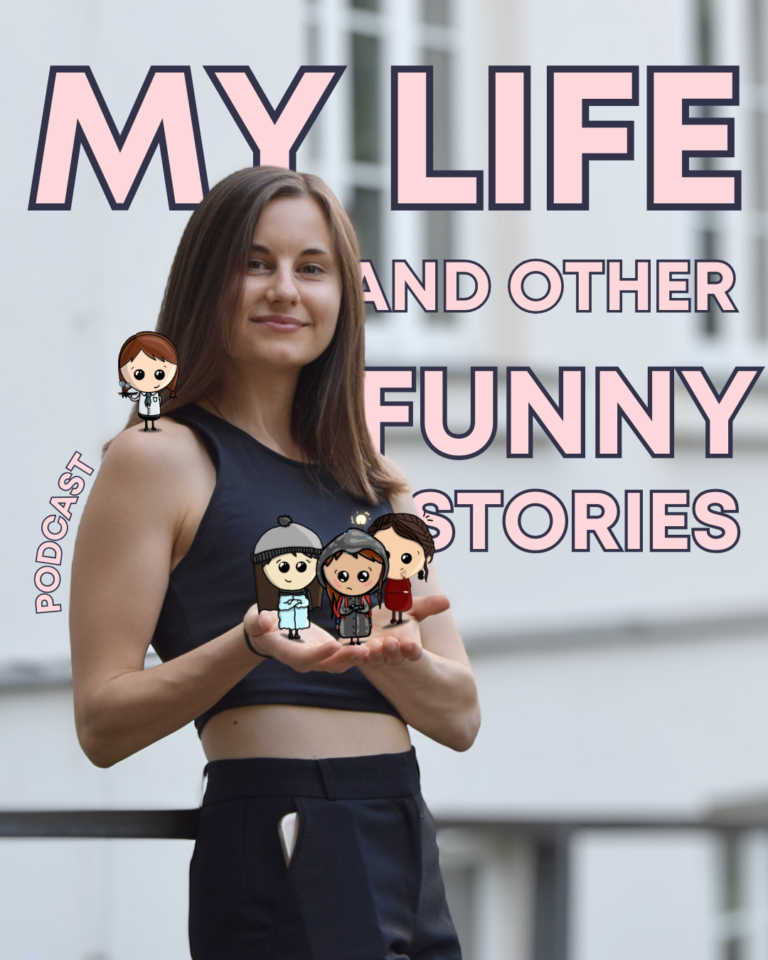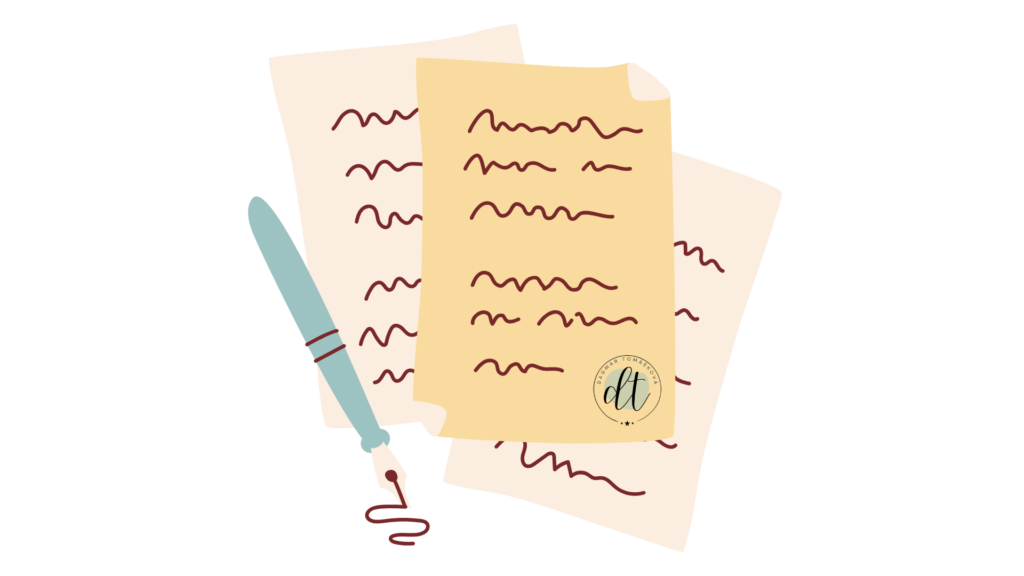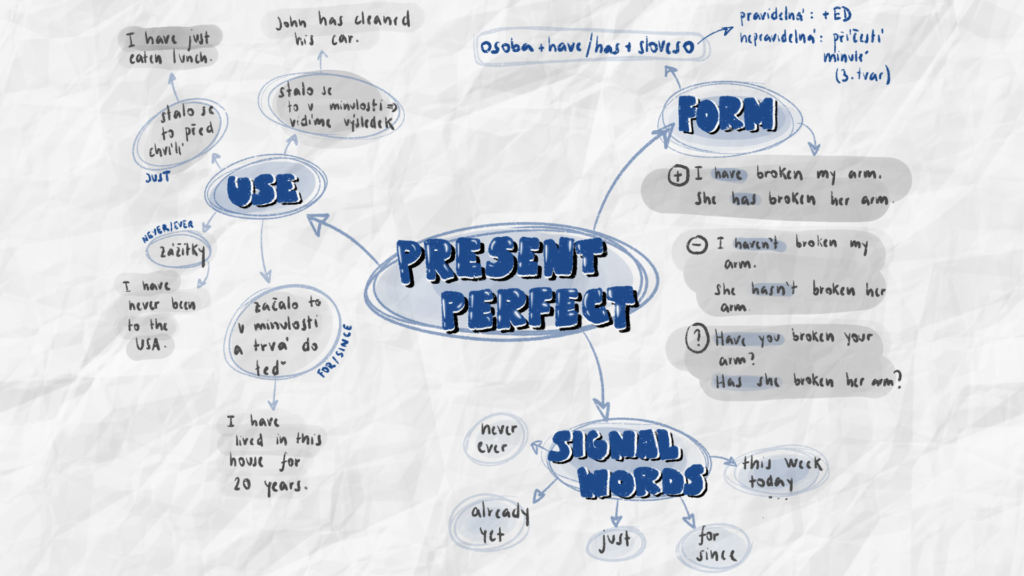
Ep.49: Explaining Present Perfect Through Stories
Today I have decided to make a little bit different episode than usual. I wanted to talk about grammar. So boring, am I right? I wanted to talk about a tense that is very problematic for Czech students and that is present perfect, in Czech “předpřítomný čas”.
But don’t worry, I will try to make it interesting, at least a little bit. And I also prepared a little present for you- a grammar mind map that I drew that will help you orient yourself in that tense. You will find it in the transcription of the podcast. So let’s get into it!

LISTEN TO THE EPISODE HERE:


WRITTEN TRANSCRIPTION OF THE PODCAST
Hello and welcome to my podcast My Life and Other Funny Stories. My name is Dagmar Tomášková, I am an English tutor and coach and I created this podcast for English students who want to improve their oral comprehension. As always you can find the transcription of this episode and vocabulary list in the notes of the podcast.
Today I have decided to make a little bit different episode than usual. I wanted to talk about grammar. So boring, am I right? I wanted to talk about a tense that is very problematic for Czech students and that is present perfect, in Czech “předpřítomný čas”.
But don’t worry, I will try to make it interesting, at least a little bit. And I also prepared a little present for you- a grammar mind map that I drew that will help you orient yourself in that tense. You will find it in the transcription of the podcast. So let’s get into it!
When I meet new students on consultations before our collaboration, I hear very often: “I know present simple, past simple and future but I always get lost in present perfect”. And I understand. We, Czech people, don’t really have present perfect in the Czech language so even though we know the grammar, it is really difficult for us to include it in our speech. So today, I want you to focus on it. Try to listen to it every time I use it and in what context. The more you hear it, the more natural it will be for you to use it in your own speech.
Before we get into the usage, I just want to go through the present perfect form – by that, I mean, how we create it.
Let’s look at a sentence: “I have just eaten breakfast.”. Here, the present perfect is in the words “have eaten”. This means that present perfect is built from:
- The auxiliary verb „have“ or „has“ (depending on the subject). – Don’t get scared when I say “auxiliary verb” it only means that it is a verb that helps you. For example in the present simple, we have “auxiliary verbs”- do and does. So here, the verbs that help us are “have” and “has”.
- The second part of the tense is the past participle of the main verb. The past participle is either just the past tense, if it is a regular verb, for example, “played” from the verb “play” and with irregular verbs, it is the third form. In our example sentence, we had “eaten”, which is the past participle, third form, of the verb EAT. We have eat, ate, eaten.
And last note, if we have a third person – which is HE, SHE or IT, our “helping word” is “HAS” – for example: She has seen the movie.
Okay, that is about it. See? Easy peasy!
Uses of the Present Perfect
Now let’s look at the more difficult part and that is the uses of present perfect. This tense is used in several ways, and to make it more interesting, I’ll tell you some funny stories to illustrate each point. In general, the present perfect connects the past to the present so usually, we have to have some connection from the past that is still influencing the current situation.
1. When We See the Result of Something
Imagine this: You walk into your friend’s house, and you see them with a brand new haircut. You say, “Have you had a haircut?” They smile and say, “Yes, I have!” The present perfect is great for this situation because you see the result right in front of you – your friend’s new haircut. So here, we can connect the result, which is the haircut, with some action in the past, which was cutting the hair.
Let me illustrate this point in an anecdote from my life (by the way, an anecdote is a short amusing story from someone’s life).
I was about 5 years old. I had a very cute haircut – longer brown hair and bangs. Bangs are the parts of hair that go across your forehead. Anyway, my 5-year-old brain decided, that those bangs needed some adjustment and took it into my own hands. My mum left me alone for like 20 minutes so what else was I supposed to do other than take scissors and cosplay as a hairdresser? When my mum came back, she was stunned: “Have you cut your bangs?” she exclaimed as she saw the uneven strains of hair on my forehead.
To be honest, I don’t remember what I answered because I was five but do you know what I remember? That it was a kindergarten photoshoot the next day. Yes, I cut my hair one day before the photoshoot. It wasn’t THAT bad but now the photo will always remind me of my hopes to become a hairdresser when I was five.
So that is the first use – when you see a result of something.
2. When Something Started and It Is Still Ongoing
The present perfect is also used when something started in the past and is still happening now. For example, “I have lived here for 20 years.” Here it highlights the fact that it is not finished yet and it is still true.
This is one of the most common areas where we use present perfect. I can say it about so many things. For example, we always use it when we want to say how long we have lived somewhere. Let me give you an example:
I came to Brno when I was 19 which means that I have lived here for 7 years now. But I have lived in my current apartment only for 5 month now. When it comes to my job, I have been an English tutor since April 2020. Again, something that started in the past and is still true.
Keywords that you can look for when talking in this case are “FOR” or “SINCE” – as you might have noticed, we use FOR if we want to talk about the duration of the action – for example, I have lived here FOR 5 months and we use SINCE if we want to talk about the specific time when it started. For example, I have been an English tutor since April 2020.
How long have you lived in your city? Or in your current house or apartment? Try to answer with present perfect.
3. When Something Has Just Happened
We use the present perfect to talk about something that has just happened. The key word here is “JUST”. If you want to talk about what has JUST happened, always use the present perfect. I always explain it in a way that it happened such a short moment ago that it still influences the present.
Now I will tell you a little embarrassing story about myself but you know what, I have told you so many embarrassing stories since I started this podcast that it doesn’t really bother me anymore. Anyway, once I went to pick up my friend from a train station at night while staying at my parent’s house. I borrowed my mum’s car and I was reversing out of our parking spot. The thing is, I do it almost on autopilot as it is the same every time. However, as I was reversing, I suddenly felt a small crash and heard a weird noise. I immediately knew that I crashed into something but I didn’t know what it was. I turned around and looked into the darkness through the window. When I saw what I crashed into, I almost fainted. My brother’s car was standing there.
But as he was parking in a spot in our garden, where he usually didn’t and it was dark and I was driving on autopilot, I bumped into it. I got out of the car and went to see the damage. It wasn’t that bad but you know how men are with their cars. It was my brother’s baby.
I went to his apartment to tell him as I was sweating profusely. I came to him and said: “I have just crashed two of our cars at once”. He looked at me with surprise in his eyes. “What do you mean you have just crashed BOTH of our cars” he asked. “I mean I have just bumped into your car with our other car” I responded.
He saw on my face that I was very distressed and went with me to see what it looked like. Eventually, he was really cool about it and it was just a small scrape but since then, I have always double-checked for parked cars even if I know there are none.
4. When We Talk About Experiences We Have or Haven’t Experienced
Finally, the present perfect is used to talk about our experiences. Something that we have or haven’t experienced.
So for example I can tell you about a few experiences that I have or haven’t experienced:
- I have never been to a different continent outside Europe if you count Iceland as being officially part of Europe.
- I have never jumped out of a plane.
- I haven’t been to the USA yet.
- I have already finished my university studies.
- I haven’t bought my own apartment yet.
Here, as you can see, the signal words are NEVER, EVER, ALREADY and YET. If you use these, there is a big chance it is a place for present perfect.
And what is something that you haven’t done YET but you want to do in the future? If you want to practice present perfect, write me a message on Instagram and let me know!
That is all I have for you today. Thank you for listening! If you liked this episode, please leave a five-star rating and share it with your friends. Don’t forget, you can find the transcript and vocabulary list in the podcast notes. See you next time.

VOCABULARY LIST
boring – nudný
a grammar mind map – gramatická myšlenková mapa
speech – řeč
auxiliary verb – pomocné sloveso
the past participle – příčestí minulé
easy peasy – lehké jako facka
to influence – ovlivnit
current – současná
bangs- ofina
to cosplay as a hairdresser– hrát si na holiče
to be stunned – být v šoku/ v úžasu
uneven – nerovnoměrný
strains – prameny (vlasů)
photoshoot – focení
key words – klíčová slova
embarrassing– ostudná
to reverse – couvat
darkness – tma/ temnota
damage – škoda
to sweat profusely – strašně se potit
scrape– škrábanec
